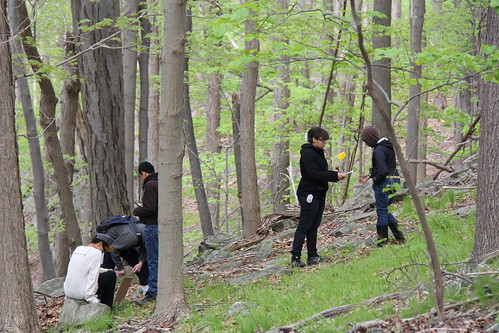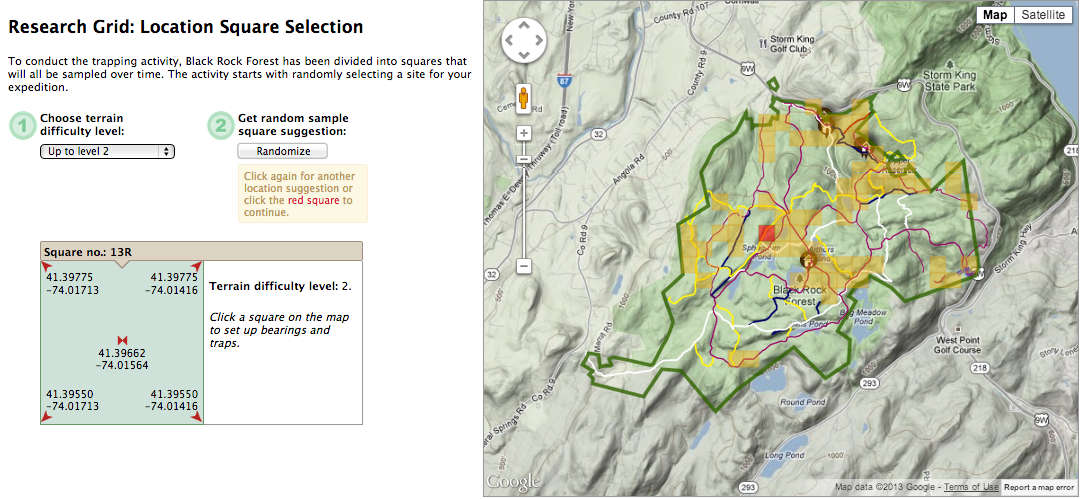 |
This spring, New York City students and teachers will head to the forest to encounter mammals - and science lessons - in their natural habitat, thanks to an initiative of the Columbia Center for New Media Teaching and Learning (CCNMTL) and the Black Rock Forest Consortium (BRFC).
The program is an extension of the Virtual Forest Initiative, a project that teaches environmental science with web-based, interactive tools that use real data from the Black Rock Forest north of New York City. In 2011, the Black Rock Forest Consortium was awarded a $500,000 grant from the Toyota USA Foundation to develop two educational modules - on chemistry and biology - for Harlem schools. The grant also supports class field trips to the Forest, where students can experience the forest first-hand and apply what they have learned from the online modules.

The first module, on water chemistry, was launched in late 2012. Over 300 students used the curriculum, and teachers praised the activities as fun and uniquely engaging.
CCNMTL and BRFC recently launched the second module, focusing on mammals and habitats, at several New York City schools serving disadvantaged youth. In this module, students become citizen researchers by taking part in a long-term study to identify Black Rock Forest mammals in various habitats.
Jeff Kidder, Director of Education at BRFC, led the creation of a mammals-centric curriculum, which covers various topics ranging from form and function of skulls and pelts to biological evolution of species. Kidder called on CCNMTL to create a randomized grid sampling tool of the forest for the mammals and habitats module. In the latter, students learn about mammals' eating habits as well as habitats in which they live.

The mammals and habitats module includes an overnight trip to the Black Rock Forest, during which students visit a particular area of the forest and identify the habitat and the mammal population in the area. Before the trip, students do in-class activities that show how an animal’s physiology - such as its teeth, skull, and pelt - relates to the habitat it lives in. They also learn and practice “orienteering” skills, such as using a compass to navigate from one point to another. Teachers and students have access to an online playground grid, which mimics the real research grid used in the field and prepares them for the vocabulary and tools used during the activity at the forest.

The data students collect during the field activities becomes an integral part of real scientific research. “The Virtual Forest [website] allows us to share data collected over years, and then we can ask meaningful questions about it," said Kidder.
Over time, by repeated use of the mammals and habitats module, the forest's habitats will emerge and be represented as colorful overlays on an interactive, online habitat map. The map, also developed by CCNMTL for this module, will show the first name of the students who located the mammals along with their school.
As the initiative continues, CCNMTL will investigate the interplay between the classroom, web-based, and field components of the project and study how the online preparatory exercises can improve the educational value of activities in the field. A variety of assessment data will be collected from both student and teacher participants over time. This data will help the project team improve each subsequent use of the educational modules, particularly the design and sequencing of the exercises.
About Black Rock Forest
Black Rock Forest, located 50 miles north of New York City in the Hudson Highlands, offers a natural laboratory that comprises 3,830 acres of forest for scientific researchers, educators, students, and the public to visit and study. In 2007, CCNMTL partnered with the Black Rock Forest Consortium to create the Virtual Forest Initiative—a project aimed at supporting and enhancing research, education, and community activities at the Black Rock Forest. In partnership with professors from Columbia University and Barnard College's Earth and Environmental Sciences Department, CCNMTL developed four interactive online educational modules that provide students with lessons on environmental science practices, such as conducting forest sampling, understanding and analyzing tree respiration, and identifying pollen grains and plant macrofossils. These are being used in several courses at the University and are also open to the public.
Learn more about the Virtual Forest Initiative at https://blackrock.ccnmtl.columbia.edu/portal.
Related news:
May-16-2014: Video: Virtual Forest Tools Enhance Science Learning and Research
Mar-05-2013: Connecting NYC Students to the Forest, Virtual and Real
Mar-02-2011: Toyota Foundation Grant Enhances Science at Harlem HS
Aug-05-2010: Virtual Forest Initiative Featured at the Ecological Society of America Meeting
Mar-11-2010: Barnard Students Engage with New Virtual Forest Module
Jul-09-2009: Virtual Forest Initiative Modules Piloted at Columbia University
Jan-14-2009: CCNMTL Develops Educational Materials and Technologies for the Virtual Forest Initiative

 NEWS FEED
NEWS FEED